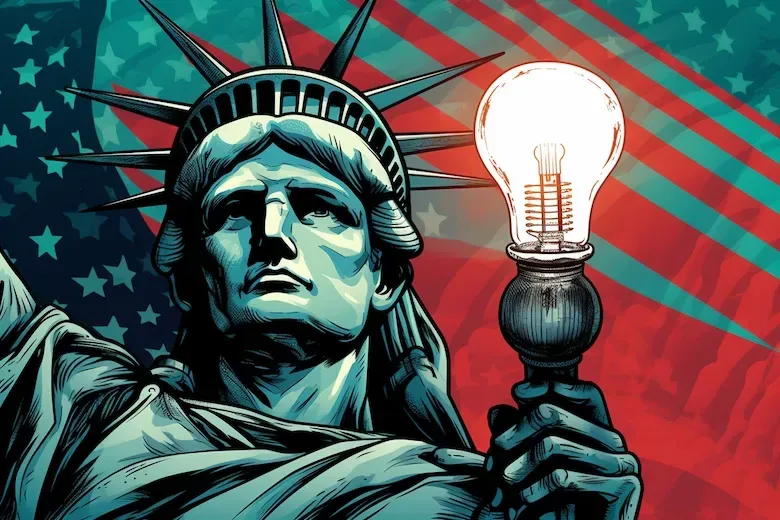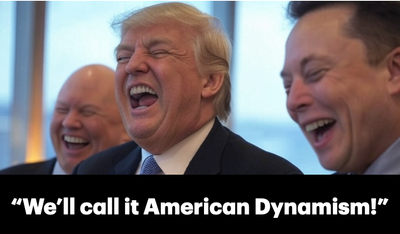America's Innovation Paradox

We are on the verge of a new phase of innovation that holds great potential for society. While everyone in the market knows it, it remains nearly impossible to obtain the necessary funding. Meanwhile, we also know countries like China are making significant progress in digital infrastructure development, posing a real and apparent threat to global economic dominance.
I have dubbed this problem America's "Innovation Paradox," which arises from the mismatch between the current capital investment thesis and the necessity of investment into nationwide sustainable digital infrastructure initiatives.
To understand this paradox better, let's explore a historical example of infrastructure investment in America and the lessons we can learn from it.
In the 1800s, the invention of the steam engine led to the rapid expansion of railways. Steam locomotives revolutionized transportation, connecting regions, opening new markets, and fostering trade, commerce, and new real estate opportunities on an unprecedented scale.
Similarly, society stands at the brink of another significant innovation phase, the Era of Autonomy. This era will drive financial growth as the Internet Economy transitions to the Machine Economy. However, a severe lack of capital hinders the infrastructure investments necessary to realize this potential. As a result, American innovation risks falling behind while countries like China embrace and advance digital infrastructure, which has the genuine potential to shift the center of global economic power.
While the rest of the world was bottoming out thanks to the unprecedented greed that caused the housing market collapse, the Communist Party of China (" CPC") was embarking on its 12th five-year plan, another masterpiece in central planning. "The inevitable way to promote scientific development is to maintain the cardinal line of speeding up the transformation of economic development," the plan reads. "Promote the deep fusion of rising technologies and industries based on major technological breakthroughs and development needs, and develop new strategic industries into leading and pillar industries while continuing to strengthen and enlarge high-tech industries."
Fast forward a decade since the publication of this plan, and the evidence of progress is everywhere, especially in the development of intelligent automation. Beijing has successfully mobilized its leading tech companies like Alibaba, Baidu, Didi Chuxing, Huawei, and Tencent to accelerate what the CPC calls "digital cities." Alibaba's "City Brain" is one of the leading case studies in the early application of Artificial Intelligence (" AI") as a foundation for smart city infrastructure. In 2020, the CPC announced a commitment of USD$1.4T to establish global dominance in emerging innovation by the year 2025.Although those controlling capital recognizes the opportunities and threats on the global stage, funding infrastructure development that competes with the likes of China clashes with the prevailing investment thesis. This conflict is rooted in the early days of the Internet over 25 years ago. At that time, the world was captivated by the potential of the Internet, and capital poured into the telecommunications industry. However, the returns on these investments did not meet expectations, leading to a significant economic bubble. The lessons learned from this period have influenced the approach to infrastructure investment ever since.
By 2021, spending on cloud infrastructure services reached $178 billion annually, indicating continued growth and potential. However, infrastructure investing has shifted towards a non-speculative approach.
Today, the focus is on building infrastructure in response to demand, more so than speculative investments. Investors in digital infrastructure projects, like data centers or fiber optic networks and renewable or sustainable energy projects typically require long-term revenue contracts to secure financing, or some sort of financial allocation from the government. These contracts ensure a steady cash flow to repay the debt incurred during the project. Obtaining funding for these infrastructure projects without such revenue contracts becomes challenging.
Frankly, this investment approach is insufficient to support America's future needs, and if we don't resolve America's Innovation Paradox, we will suffer.
Infrastructure investing must adopt a multi-generational perspective on ownership and returns. The railway industry was fueled by visionary industrialists willing to take speculative risks to create generational wealth. Figures like Vanderbilt, Gould, Carnegie, and Morgan made substantial investments in railway projects, reshaping the industry and leaving a lasting legacy. The investment thesis of the railway development era was imbued with a homesteading mentality. Homesteading refers to settling and cultivating land with a long-term vision. The historical infrastructure investors saw their investments as more than just a single capital project; they aimed to create a lasting impact.
Modern infrastructure investors with a true homesteading mentality are few and far between. Today, project financing infrastructure is primarily focused on a "build it when they come" mindset. This means that investments are made based on the anticipation of future demand. It is a cautious approach that requires assurance of high watermark pre-committed revenue thresholds before deploying significant capital. This cautiousness stems from the lessons learned after the dot-com bubble burst, highlighting the risks of speculative investments without a solid revenue foundation.
Solving America's Innovation Paradox will require a dramatic shift in mindset. Infrastructure investment must adopt a longer-term horizon, allowing for the patient development of new economies and the resulting revenue streams and returns they will bear. Investors need to embrace a generational perspective.
Private capital could be incentivized to participate in ambitious infrastructure endeavors by taking a long-term outlook on revenue creation and return. Doing so requires aligning the thesis of investing with the vision of building for the future and recognizing that the gains for the investor may extend beyond the immediate deployment of capital. The winners in the railway expansion didn't win because they owned a railway. They won because they held portions of an economy formed on and around the railway. In the same way, modern infrastructure investors need to think beyond short-term financial results and consider the lasting impact and potential for generational wealth creation that nationwide infrastructure projects can bring.
The homesteading mentality of visionary investors not singularly focused on immediate returns from captive projects is crucial for resolving America's Innovation Paradox. There are valuable lessons and playbooks for us in the history of industries such as railways. Perhaps by channeling the spirit of disrupting the status quo imbued by industrialists like Vanderbilt, Gould, Carnegie, and others, we can remake the modern infrastructure investment thesis and forge a prosperous and environmentally sustainable future that will keep America great for centuries.
No spam, no sharing to third party. Only you and me.







Member discussion